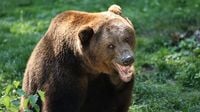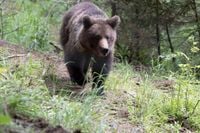The German Foreign Office has issued a cautionary travel advisory for Romania, urging tourists to exercise extreme caution when venturing into the Carpathian Mountains. This advisory comes in response to a series of deadly bear attacks on hikers, highlighting the significant risk posed by the region's large bear population.
In the advisory, uploaded on April 12, 2025, the Foreign Office noted, "In the Romanian Carpathians, there is a larger free-roaming bear population. Bears come into populated areas and roads in search of food, such as along the Transfăgărășan road. Several serious, sometimes fatal attacks on passers-by and hikers have been reported." This stark warning aims to prepare travelers for potentially life-threatening encounters with bears.
While the Foreign Office has not issued an official travel warning against visiting Romania, it urged tourists to heed local signs and warnings, and to follow the instructions of local authorities. Travelers are specifically advised to keep their distance from bears and avoid feeding them, as this can encourage dangerous interactions.
Bear encounters have become increasingly common in Romania, particularly in the Southern Carpathians, where an estimated 8,000 brown bears live—making it home to the largest bear population in Europe, second only to Russia. These bears are known to wander into human habitats, seeking food, which can lead to dangerous confrontations.
According to reports, the risk to human life is significant. Over the past 20 years, 26 people have died from bear attacks in Romania, with more than 270 others injured. The situation has escalated to the point where the Romanian government has increased the annual bear shooting quota from 140 to nearly 500 for the years 2024 and 2025. This decision reflects a growing concern over the rising number of bear-human conflicts.
The Foreign Office's advisory comes just ahead of the Easter holiday, a peak time for travel. As many tourists plan their trips to Romania, the Foreign Office emphasizes the importance of understanding the risks associated with bear encounters. Travelers are encouraged to familiarize themselves with safety guidelines for bear interactions, which include remaining calm, avoiding sudden movements, and signaling their presence through quiet speaking if they find themselves close to a bear.
In the event of an attack, experts recommend lying face down on the ground to minimize perceived threat, as bears may not recognize a person as a danger. Escaping is generally discouraged due to the bears' speed and climbing ability, unless a safe location is immediately accessible.
The increase in bear attacks has sparked a debate in Romania regarding wildlife management and public safety. The Romanian government has implemented measures to address the growing bear population, including allowing the hunting of aggressive bears, commonly referred to as "problem bears." Since 2016, hunting brown bears has been generally prohibited, particularly trophy hunting, which has been popular among foreign tourists.
The most recent fatal incident occurred in July 2024, when a 19-year-old tourist was killed by a bear while hiking in the Bucegi Mountains. This tragic event, along with previous attacks, has intensified discussions about how to effectively manage the bear population and ensure the safety of both tourists and local residents.
In addition to the travel advisory for Romania, the Foreign Office has also issued warnings regarding bear encounters in Italy. In mid-July 2024, a jogger was attacked and injured by a bear north of Lake Garda, and in 2023, a jogger was killed in a separate incident. These events underscore the broader issue of human-wildlife interactions in Europe, particularly as bear populations continue to thrive in regions where they come into contact with people.
Travelers planning to visit Romania are urged to stay informed about the risks associated with bear encounters. By adhering to safety guidelines and respecting wildlife, tourists can enjoy the natural beauty of the Carpathians while minimizing the chances of dangerous interactions with bears.
As the popularity of Romania as a travel destination grows, balancing tourism with wildlife safety will be crucial. The Foreign Office's updated travel advice serves as a reminder that while the allure of observing bears in their natural habitat can be enticing, it is essential to approach such experiences with caution and respect for the animals and their environment.





